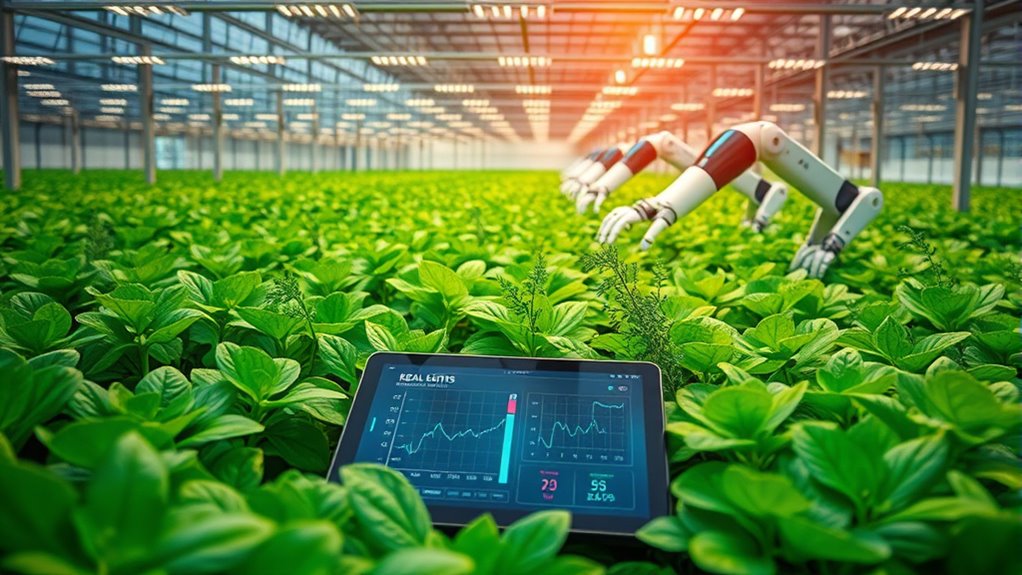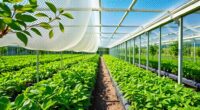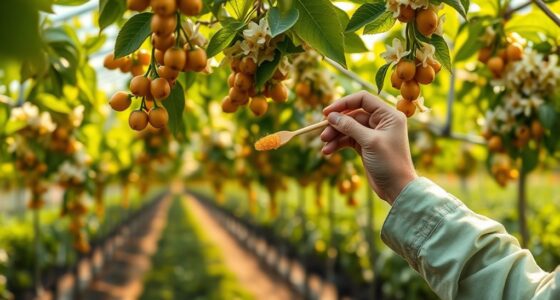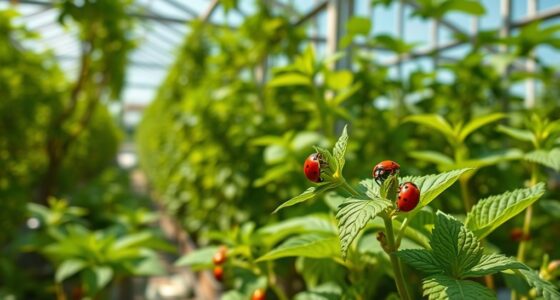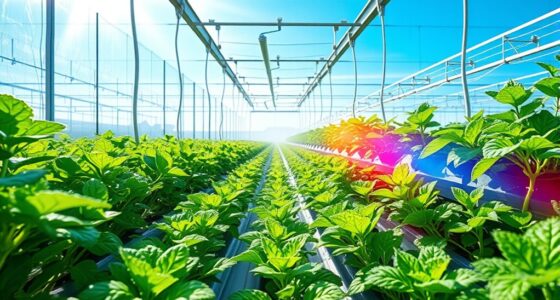AI plays an essential role in modern greenhouse management by optimizing resource use, enhancing climate control, and boosting crop productivity. By utilizing real-time data and advanced technologies, you can reduce energy and water consumption while improving crop yields and quality. With systems that detect pests early and predict climate patterns, AI guarantees your greenhouse operates at peak efficiency. There’s even more to discover about how AI can transform your agriculture practices for the better.
Key Takeaways
- AI optimizes resource utilization in greenhouses, reducing water, fertilizers, and energy consumption for sustainable practices.
- Predictive analytics and real-time monitoring enable proactive climate control, improving crop yields and minimizing energy waste.
- Automation of routine tasks and crop monitoring enhances efficiency, reducing reliance on manual labor and ensuring consistent plant health.
- AI-powered image recognition detects early signs of diseases and pests, allowing for timely interventions and improved crop quality.
- Integration of IoT devices provides continuous data for informed decision-making, enhancing overall greenhouse management and productivity.
The Integration of AI in Greenhouse Operations
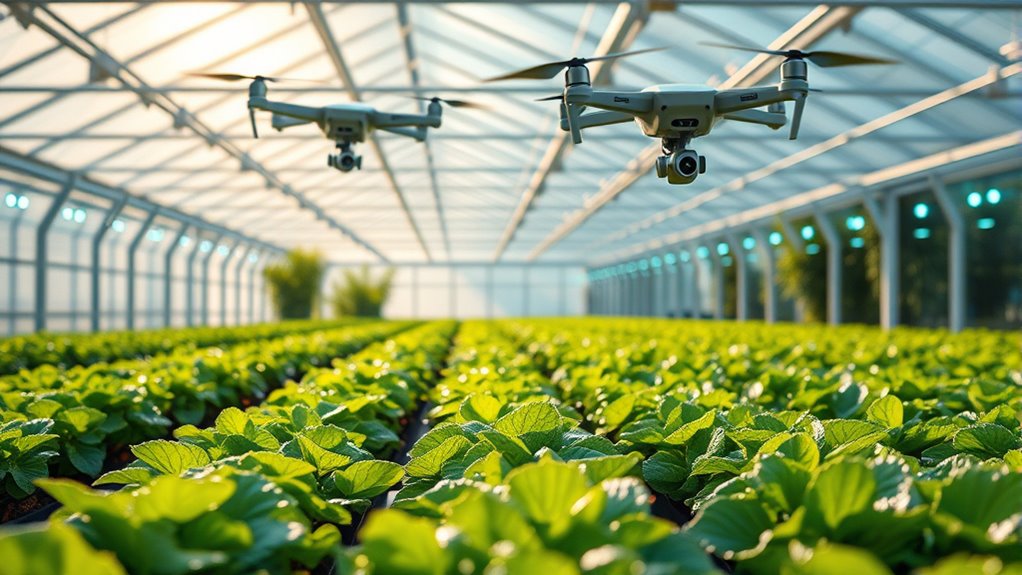
As greenhouse managers increasingly embrace technology, integrating AI into operations has become a game changer. AI enhances resource utilization, so you can use less water, fertilizers, and energy while still achieving great results. Data collection from greenhouses is crucial for farmers to enhance operations, as it allows for more precise adjustments to environmental conditions. Additionally, implementing battery-less inverters in greenhouse operations can optimize energy usage by directly utilizing solar power generated on-site.
With real-time data analysis, you’ll notice improved crop yields and quality, thanks to ideal growing conditions and early disease detection. Furthermore, understanding water sources is vital for optimizing irrigation practices, ensuring that plants receive adequate moisture without waste. Automation of routine tasks like seeding and harvesting reduces your reliance on manual labor, enhancing consistency. Plus, AI offers enhanced decision-making capabilities, providing insights that help you manage crops and allocate resources effectively. By integrating external data sources, such as weather forecasts, you can enhance production and boost profitability, making your greenhouse operation more efficient and competitive in the market. Additionally, the integration of AI in greenhouse management aligns with the growing trend of renewable energy technologies, promoting sustainable practices that benefit both the environment and the economy.
Enhancing Climate Control With AI
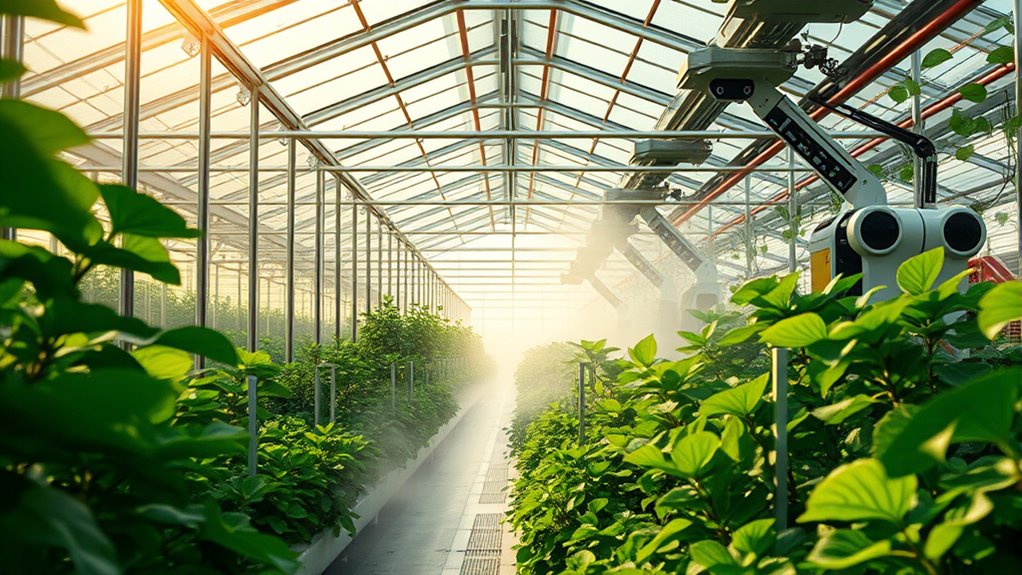
Integrating AI into greenhouse operations not only streamlines resource management but also enhances climate control, a vital aspect of successful plant growth.
AI-driven systems use advanced weather prediction models to anticipate climate changes, allowing you to create three-day climate strategies based on localized data. This proactive approach adjusts temperature and humidity levels, ensuring stable growing conditions while minimizing energy waste. Additionally, AI-driven climate control predicts and optimizes greenhouse conditions in advance, leading to better overall management. By implementing sustainable practices, you can further enhance the benefits of AI in your greenhouse operations. Moreover, the integration of renewable energy technologies can significantly lower operational costs while maintaining optimal conditions for plant growth. AI also enhances indoor and outdoor humidity, preventing condensation and reducing disease risks.
Furthermore, utilizing heat pump technology for climate control can complement AI systems by providing efficient heating and cooling solutions tailored to greenhouse needs.
With digital twin technology, you can simulate various climate scenarios, helping you make informed decisions before implementation.
Ultimately, AI not only improves energy efficiency but also supports consistent crop quality, ensuring your plants thrive in ideal conditions.
AI’s Impact on Crop Management
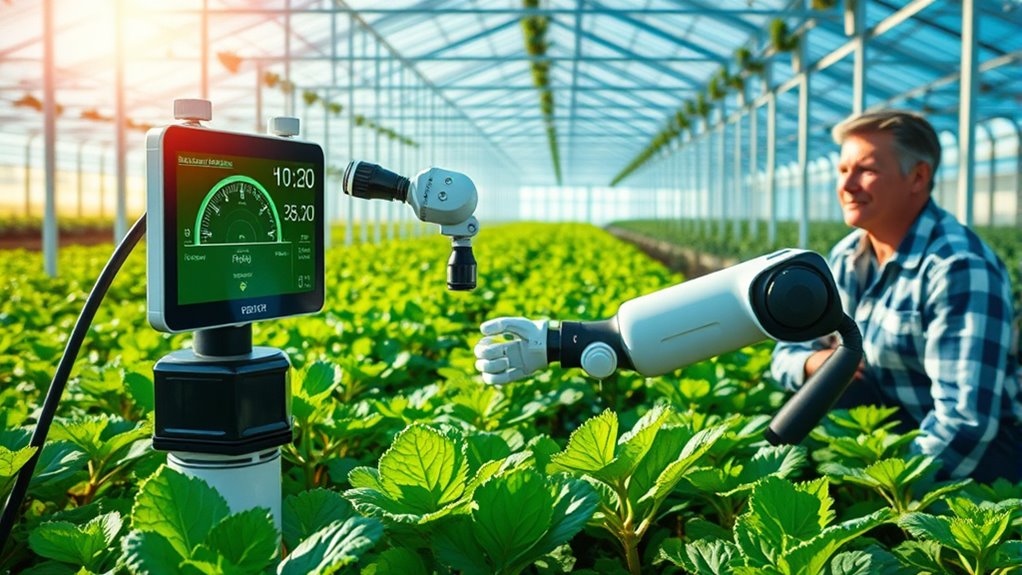
Harnessing AI’s capabilities in crop management revolutionizes how you monitor and nurture your plants.
With AI-powered image recognition tools, you can detect early signs of disease or pest infestations, allowing for swift action that minimizes crop damage. The use of positive affirmations can also enhance your mindset towards successful crop management. Additionally, music therapy can improve emotional well-being and reduce stress, which may positively influence your management decisions. The integration of AI across industries is paving the way for innovative solutions in agriculture.
Predictive analytics enable you to anticipate climate patterns and potential issues, ensuring proactive management.
Predictive analytics empowers you to foresee climate trends and challenges, fostering proactive crop management strategies.
AI systems assess plant health by tracking growth stages and nutrient levels, providing valuable insights for optimizing crop yield. AI analyzes data for optimal growing conditions in real-time, enhancing decision-making.
Automated crop tracking guarantees consistent monitoring, leading to data-driven decisions.
By processing vast amounts of data, AI delivers actionable insights, ensuring you maximize your resources and improve overall crop quality.
Embracing AI in crop management transforms your approach and enhances your greenhouse’s productivity.
Sustainability Through AI Solutions
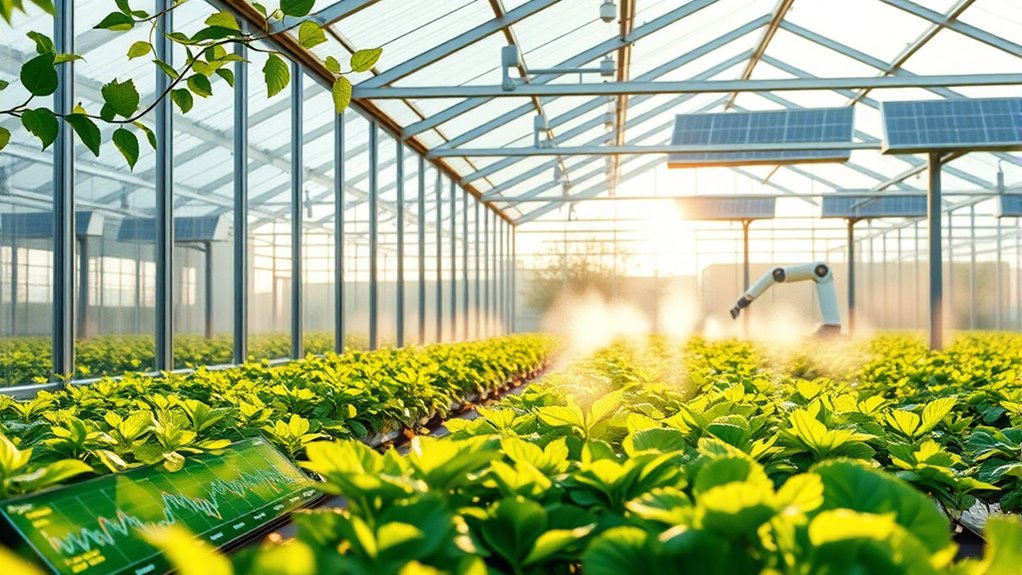
By leveraging AI solutions, you can greatly enhance sustainability in greenhouse management. AI optimizes energy consumption, potentially cutting heating costs by up to 25%. It also helps manage resources like water and fertilizers more efficiently, minimizing waste and reducing your environmental impact. With real-time monitoring, AI enables you to detect issues early, allowing for timely interventions. Additionally, solar-powered irrigation systems can be integrated with AI to enhance crop yields and efficiency, further improving the sustainability of your operations. AI and IoT combine to improve farming efficiency and productivity, further enhancing the sustainability of your operations. Predictive maintenance guarantees your equipment runs smoothly, lowering downtime and further decreasing the environmental footprint. Additionally, AI promotes sustainable practices by minimizing reliance on artificial lighting and optimizing CO₂ emissions. Moreover, incorporating organic methods in your greenhouse can enhance the nutritional profile of your crops, aligning with sustainable agriculture practices. Freshly squeezed juice, which retains nutrients, is an excellent example of maximizing nutritional value in sustainable practices.
Technological Tools for AI-Driven Greenhouses
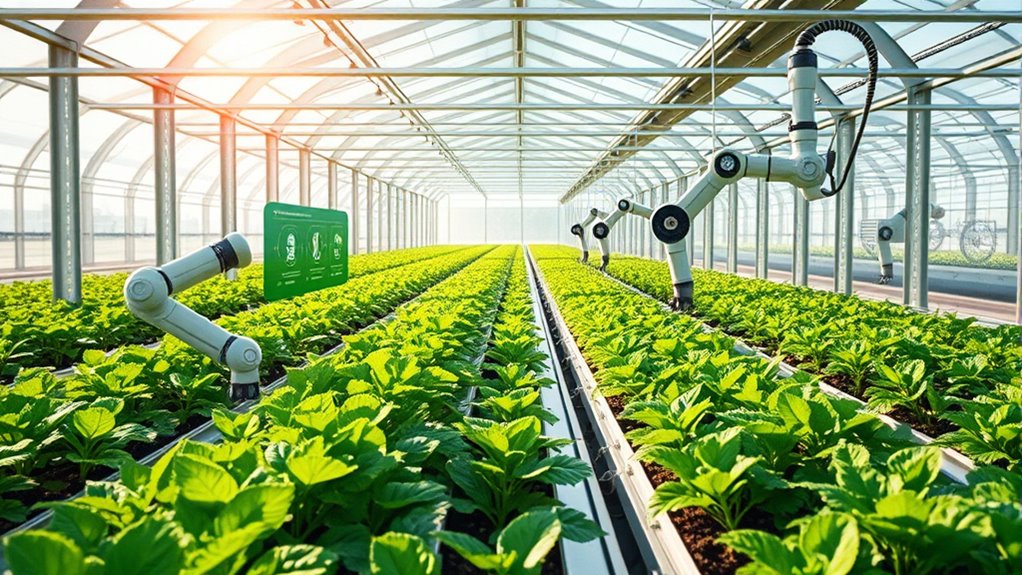
As greenhouse management evolves, technological tools are at the forefront of enhancing productivity and efficiency. AI-driven systems allow you to predict crop yields accurately by analyzing environmental conditions and plant health. With AI-powered greenhouses enabling precise monitoring, you can make data-driven decisions that optimize resource allocation and reduce risks. Autonomous climate management systems adjust temperature and humidity, while AI-controlled lighting and ventilation guarantee ideal growth conditions. Additionally, AI-powered image recognition detects diseases early, enabling proactive interventions that minimize chemical use. By integrating IoT devices, you gain access to continuous data that improves decision-making. Ultimately, these innovations lead to efficient water management, precise nutrient delivery, and higher overall productivity, positioning your greenhouse for success. Furthermore, the implementation of dynamic contrast ratios in visual monitoring systems can enhance the detection of subtle changes in plant health. Moreover, utilizing predictive modeling can further optimize your greenhouse operations by forecasting potential crop issues before they arise. This approach mirrors the trend of sustainable building materials seen in tiny house designs, which emphasizes eco-conscious practices in contemporary construction.
Future Challenges in AI Adoption
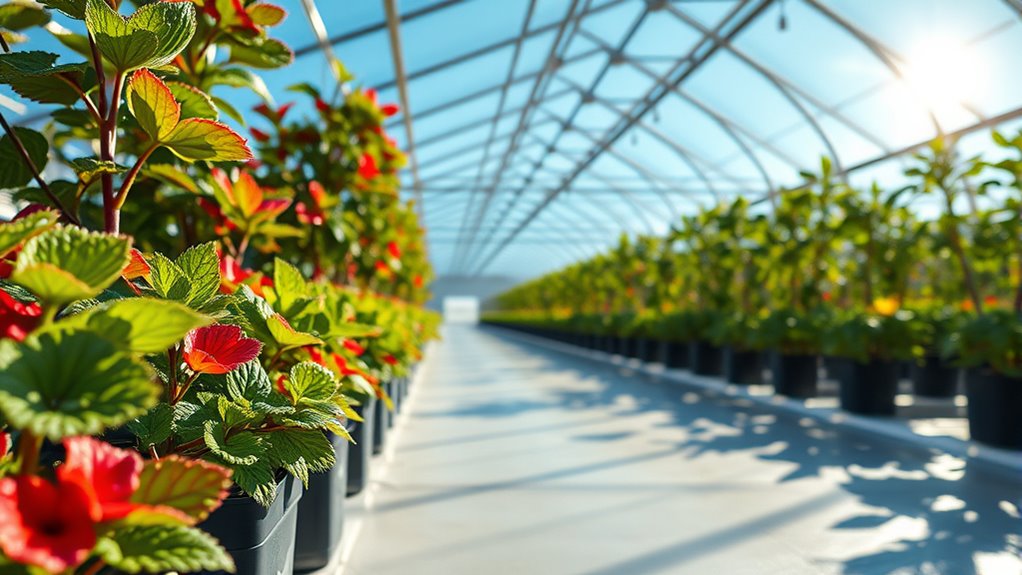
While the potential of AI in greenhouse management is promising, several future challenges could hinder its widespread adoption.
High initial costs for sensors and data systems can strain small farms, making it hard to justify the investment. Integrating AI with existing infrastructure often requires specialized skills, complicating implementation. Furthermore, adopting natural techniques for crop management can enhance the effectiveness of AI systems, making them more beneficial for growers. Estate planning can also help farmers financially prepare for investments in new technologies. Additionally, implementing balance and coordination development strategies can support the physical well-being of growers, encouraging a more holistic approach to farming.
Securing high-quality datasets for training AI models is challenging, and legacy systems may not easily adapt to these new technologies. Furthermore, automated systems that maintain ideal growing conditions are necessary to ensure that investments in AI yield positive results.
You also face data management issues, such as cybersecurity risks and the need for robust governance frameworks. Cultural resistance and skill gaps among growers may slow acceptance, while the environmental impact of AI systems must be carefully considered to guarantee sustainability in greenhouse operations.
The Role of Digital Twins in Greenhouse Efficiency
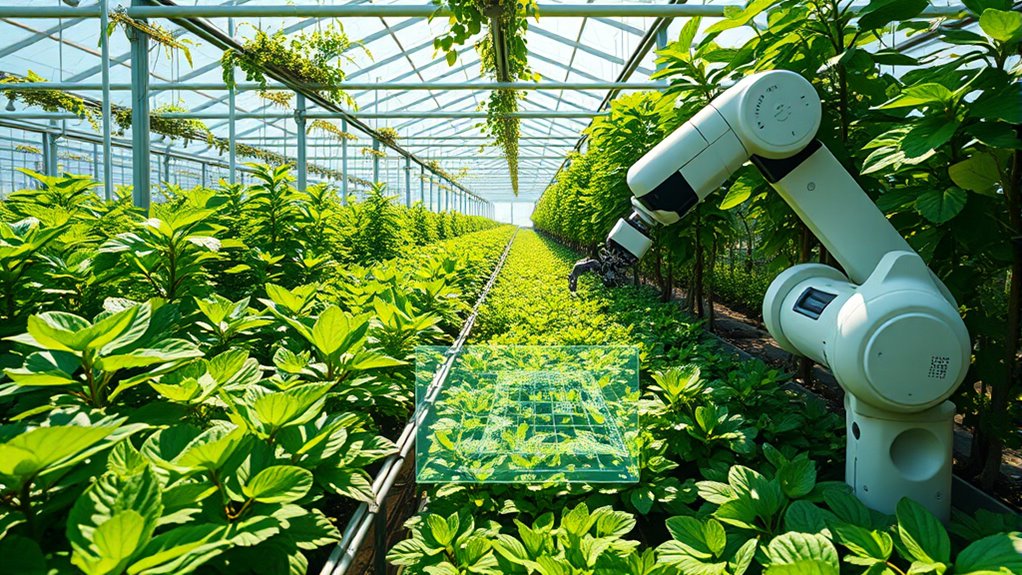
In addressing the challenges of AI adoption in greenhouse management, digital twins emerge as a powerful tool for enhancing efficiency. These virtual replicas of your greenhouse allow you to simulate scenarios and predict outcomes, leading to better decision-making. By integrating AI, digital twins enhance models and provide predictive analytics that refine your operations. They also manage energy more effectively, ensuring you purchase power at ideal times and reduce waste. This not only cuts costs but also helps meet sustainability goals by lowering CO2 emissions. Additionally, digital twins utilize real-time data from sensors to enable dynamic management, resulting in improved productivity and crop yields. Embracing this technology can transform your greenhouse into a model of efficiency. Furthermore, digital twin technology can significantly reduce your energy costs while optimizing resource usage, particularly by leveraging energy-efficient heat pumps that contribute to a more sustainable operation. Implementing regular maintenance practices for these heat pumps can further enhance their performance and longevity.
The Importance of Real-Time Monitoring in Agriculture
Real-time monitoring has become essential in agriculture, enabling you to respond quickly to changing conditions and make informed decisions that directly impact your crops. With early detection of pests, diseases, and nutrient deficiencies, you can intervene before significant damage occurs. This proactive approach maximizes resource usage, cutting costs and minimizing environmental impact. Wireless sensors track real-time data on temperature, moisture, and humidity, further enhancing your ability to optimize growing conditions. Real-time data enhances crop yield and quality by creating ideal growing conditions. Technologies like IoT sensors, drones, and AI algorithms provide you with the insights needed for precise adjustments in irrigation and fertilization. While challenges exist, such as sensor failures and implementation costs, the benefits of improved precision, productivity, and sustainability make real-time monitoring a crucial component of modern agriculture.
Frequently Asked Questions
How Does AI Improve Labor Efficiency in Greenhouses?
AI improves labor efficiency in greenhouses by automating routine tasks like irrigation and climate control.
You won’t need to constantly monitor conditions, as AI systems adjust temperature, humidity, and lighting in real-time.
With predictive models, it anticipates issues before they arise, reducing downtime.
This automation frees you up to focus on higher-value tasks, cuts labor costs, and allows for better resource allocation, ultimately leading to a more productive and sustainable greenhouse operation.
What Is the Cost of Implementing AI in Greenhouse Management?
When you consider the cost of implementing AI in greenhouse management, you’ll encounter initial investments like hardware, software development, and training.
These upfront expenses can be significant. However, once integrated, AI optimizes energy use and resources, leading to long-term savings.
Ongoing costs include maintenance and data management, but the efficiencies gained can outweigh these.
Ultimately, the decision should weigh both immediate costs and potential long-term benefits for your operation.
Can AI Systems Work With Existing Greenhouse Technologies?
Imagine stepping into a greenhouse, where every plant thrives under perfectly balanced conditions.
Yes, AI systems can seamlessly integrate with your existing greenhouse technologies. They enhance your climate control, optimize watering schedules, and even monitor for pests.
With real-time adjustments and data analysis, AI doesn’t just coexist; it elevates your current setup, making it more efficient and sustainable.
You’ll find that your crops flourish like never before, thanks to this intelligent partnership.
How Is Data Privacy Handled in Ai-Driven Greenhouses?
In AI-driven greenhouses, handling data privacy is essential.
You’ll want to guarantee data collection is limited to what’s necessary, minimizing risks. Implementing robust access controls protects sensitive information, while transparency about how data is used builds trust.
Regular audits help identify vulnerabilities, and techniques like data anonymization can safeguard individual privacy.
What Skills Are Needed to Operate AI Systems in Agriculture?
Steering through the vast ocean of agriculture requires a sturdy ship of skills to harness AI’s power.
You’ll need proficiency in AI tools, data interpretation, and software management, like a captain skilled in charting the course.
Analytical thinking is your compass, guiding you through complex data.
Leadership and management skills guarantee your crew works harmoniously.
With adaptability, you’ll weather any storm of innovation, transforming challenges into opportunities for growth and efficiency.
Conclusion
Incorporating AI into greenhouse management is reshaping agriculture for the better. With AI-driven solutions, you can boost crop yields by up to 30%, making your operations more efficient and sustainable. As you embrace these technologies, remember that real-time monitoring and digital twins are key to maximizing your greenhouse’s potential. By harnessing the power of AI, you’re not just improving productivity; you’re paving the way for a smarter, more sustainable future in farming.
